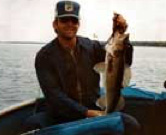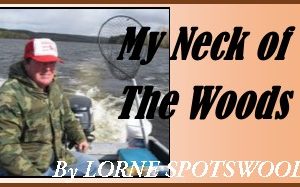
From historical documents, we know that fish populations of the nation’s rivers were incredible. As development of the 1900’s took place along the shorelines and industry abused the rivers, fish populations declined and most anglers turned to lakes in search of game fish. But within the past decade or so, a reversal is seen in this trend. With a greater emphasis for a clean environment and federal legislation, rivers began to rejuvenate themselves. In fact, even environmental scientists have been amazed at the speed with which rivers revive. With many fish populations at an all time high, it’s surprising how little fishing pressure most rivers receive.
Rivers offer some of the finest fishing anywhere. In fact, rivers have been called the Last Frontier in the angling world. One reason this frontier still remains is that river rats have been secretive about the potential of rivers and kept all the fishing to themselves.
From an ecological point of view, a lake is considered a “closed” system while a river is classed as an “open” system. In general, the materials of life (plankton, vegetation, nutrients) remain within a lake and may be used over and over. In contrast, a river receives most of its nourishment from without, and while life supporting materials may remain for a time lodged somewhere in a plant or animal, they all eventually pass downstream never to return directly. A river continuously receives new water and nourishment from the surrounding terrain since it’s the earth’s drainage system. Even those life forms which develop within the river eventually work their way to the sea, through the food chain, and out of the river’s ecosystem.
To an angler who does most of his fishing in lakes, river fishing will certainly present a challenge as well as problems. Fish behave differently in moving waters than in still waters and unless you are aware of these differences and change your technique to suit the river, unproductive hours on the water could result.
But river fishing is not necessarily more difficult; it is simply, just different. The key to understanding rivers, and how the different species adapt to the mobile environment, is to grasp the concept that a river is a moving body of water. A clear difference exists between a lake and a river. The life forms (even the same species) adapt differently, because they inhabit totally separate environments.
The major difference between a lake and a river is “current”. It’s the most important element that a fish must adjust to in a river. Like much wind on dry land, current is a mixture of many interacting natural phenomena. Current is a powerful force that has a continual effect on the entire river ecosystem.
To fish rivers effectively, you have to understand current. If not, you may fail to locate fish and your presentation will be inappropriate. Current dominates the life force of a river and is the key to fish movement and location.
Therefore, the key to be successful is learning to relate subtle current changes with the underwater structures that create them. Objects in the bottom slow, stop, reverse, divert or in some way break the flow of current and river fish are extremely sensitive to these changes. Unfortunately, these changes are not obvious to anglers. Most cannot be seen on a depth finder nor are they marked on maps. To river fish, a knife-edged wall of fast flowing water bounded by slower moving or slack water is just as real to the fish as a sharp rock drop-off.
River anglers must rely primarily on their eyes to locate current breaks. While it may be impossible to see a submerged boulder, its presence is revealed by a “boil” on the surface downstream from the actual location. Eddy currents, which circle back upstream, often occur below a point bar on an obstruction that breaks the surface. To a river rat, an eddy is as obvious as standing timber is to a reservoir angler. Of course, in slow rivers or sections of rivers that slow, there are often areas with almost no current. Watch for these situations and fish them just as you would a lake.
In addition to current, other factors must be taken into consideration; water level and fluctuation, cover and water temperature. The amount of turbidity will affect both light penetration and fish activity. Water level will determine current velocity and the overall impact of current velocity cannot be overemphasized. Water in rivers is constantly fluctuating. As water rises fish tend to move shallower and as it recedes fish move deeper into deep holes along steep banks and drop-offs. River fish learn to seek cover starting the moment they hatch. This need for cover remains with fish forever. As the fish grow larger so does the choice of cover. Unlike lakes, rivers seldom stratify into temperature layers. Anglers learn to locate the areas during the different seasons that have temperature changes.
All in all, rivers offer an unexploited and diversified angling experience that significantly increases your angling options. Now, with all that good news about river fishing, wouldn’t you like to explore the Last Frontier of the angling world?





![Kenopic/Smith Auction [Paid Ad]](https://whitewaternews.ca/wp-content/uploads/2018/10/advertising-100x75.jpeg)

